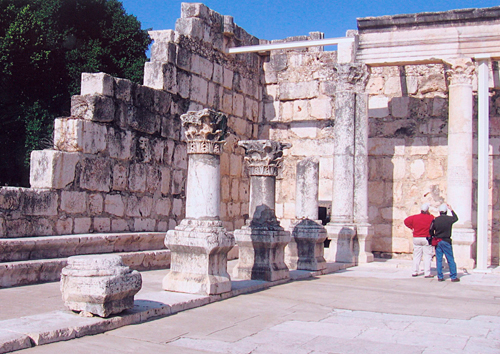What prompted Jesus to change neighborhoods – to pick up and move from his hometown of Nazareth, which is located in the heartland of the region of Galilee, to Capernaum, a small fishing village nestled against the northwestern shores of the Sea of Galilee on the fringes of the district?
 Remnant of a fourth-century synagogue built upon the the foundation of the first-century “synagogue of Jesus” in Capernaum.
Remnant of a fourth-century synagogue built upon the the foundation of the first-century “synagogue of Jesus” in Capernaum.I thought about that and much more on the day that our group of nine Southern Baptist newspaper editors set foot in Capernaum on a chilly January day to view the historical site of a hamlet that in the first century was comprised of a cluster of simple houses constructed of the local black basalt stones, and at the center of it all, flooring, standing walls and columns from the late fourth century synagogue that was built over the remains of the “synagogue of Jesus.”
The gospel writer Matthew offered strong evidence that rejection lay at the heart of the decision of Jesus to leave family and friends as he settled into a ministry of teaching and healing.
As Matthew told it, Jesus was teaching in the synagogue in Nazareth, amazing the home folks with his wisdom and miraculous powers. The people who had watched him grow up “in wisdom, stature and in favor with God and man” were apparently more angered at than awed by “this carpenter’s son,” however, as their familiarity with him grew into contempt of him.
Jesus was philosophical about it all as he told them matter-of-factly, “A prophet is respected everywhere except in his hometown and by his own family” (Good News Translation).
Perhaps they simply took him for granted.
Whatever his reason or reasons, Capernaum it was for Jesus. And Matthew observed that Jesus made Capernaum “his own city.”
Events in the life of Jesus were played out in a relatively small geographical area of the world – Israel.
In fact, all of them were – except for the journey by Jesus as a young child into Egypt with Mary and Joseph to escape harm at the hand of King Herod, and his baptism by John the Baptist, which most likely took place in modern-day Jordan.
And it was in the region of Galilee that Jesus spent most of his life and ministry.
As he settled into life in Capernaum, Jesus found a home among the fishermen of the northern Sea of Galilee. He learned from experience their style of life and the hardships they endured each day in their efforts to earn their livelihoods.
Peter, who later helped make up the “inner circle” of the disciples of Christ, along with James and John, and whose mother-in-law was healed by Jesus, lived in Capernaum.
It was in Capernaum that Jesus walked by the office of a tax collector and said to Matthew, who also was a skilled writer, “Follow me.”
The village of Capernaum provided the setting for a number of mighty works by Jesus, from healing a paralytic, a centurion’s slave and a man with a withered hand to casting out a demon.
And yet.
Luke, in his gospel, recorded that Capernaum – along with the nearby towns of Chorazin and Bethsaida, forming an “evangelical triangle” where Jesus also performed many mighty works – suffered the Lord’s rebuke for their failure to believe.
William Barclay noted in his commentary on the portion of Luke’s gospel dealing with the Lord’s condemnation of the three cities pointed out that privilege is accompanied by responsibility. “To have God’s word is a great responsibility. We will be judged according to what we have had the chance to know. There is a sense in which every promise of God that we have ever heard can become our condemnation. If we receive these promises, they are our greatest glory, but each one that we have rejected will some day be a witness against us.”
The former fishing village of Capernaum, where in the first century Jesus lived and taught and healed, is hallowed ground for believers. It also will be remembered as a town rebuked by the Lord for receiving much and believing little.